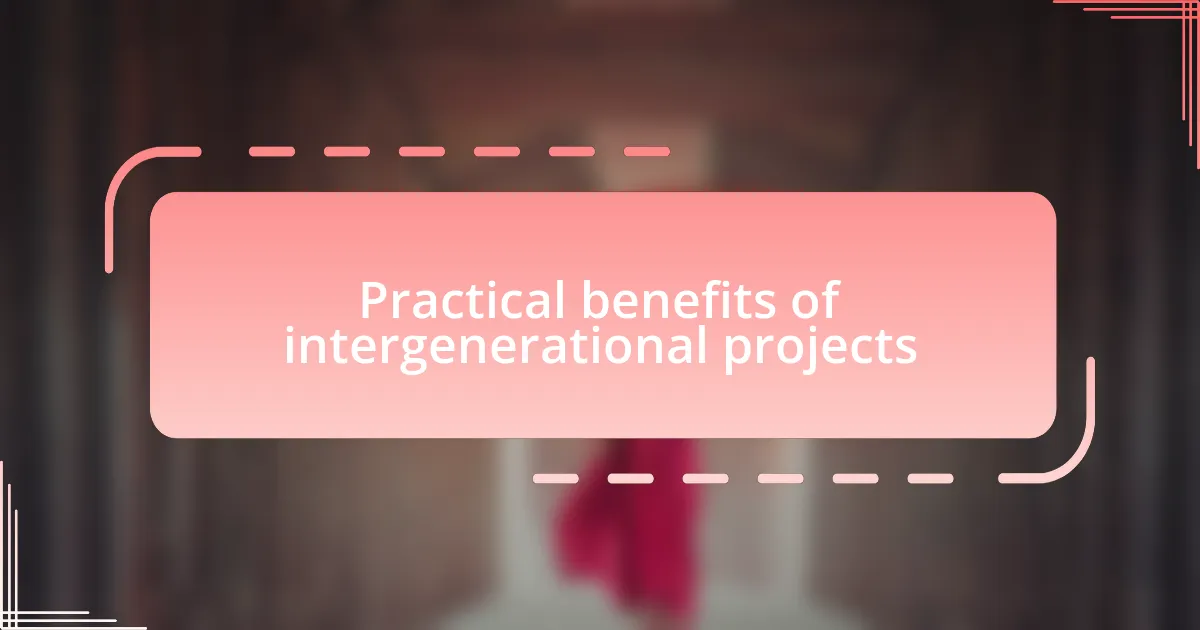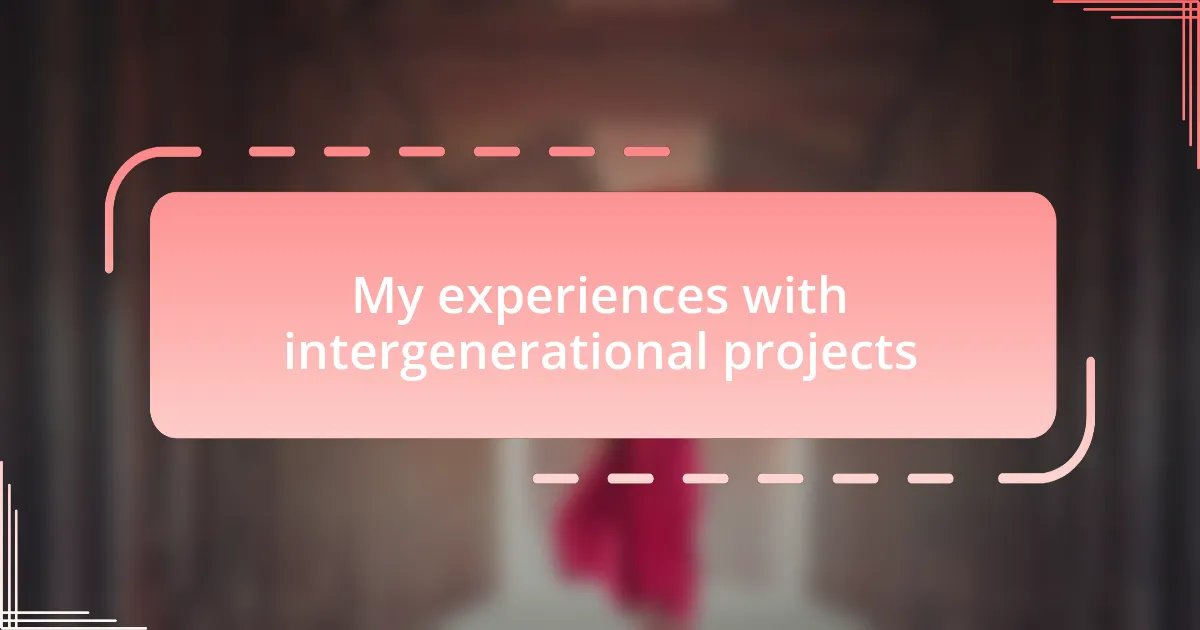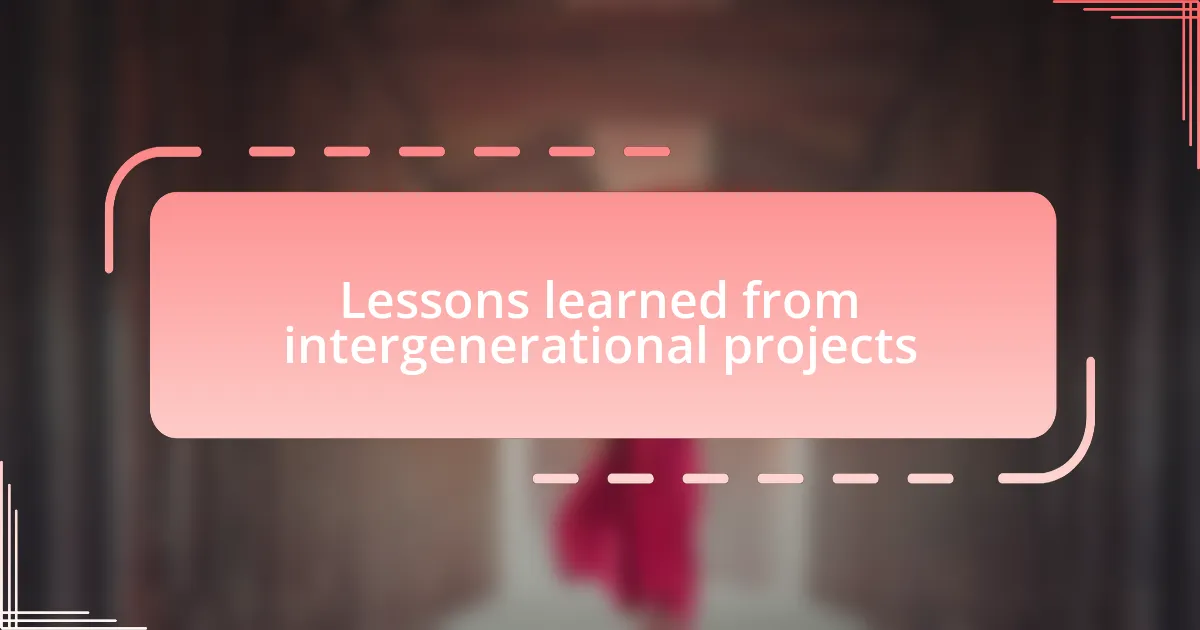Key takeaways:
- Intergenerational projects foster collaboration and understanding between different age groups, enhancing mutual respect and emotional connections.
- Participants in these projects develop essential life skills, such as technology use for seniors and empathy in younger individuals.
- Experiences like storytelling and cooking create meaningful memories and bonds, emphasizing that sharing traditions and knowledge is a two-way process.
- Effective communication in these projects extends beyond words, highlighting the importance of non-verbal cues and shared vulnerability to build deeper connections.

Understanding intergenerational projects
Intergenerational projects are fascinating initiatives that foster collaboration between different age groups, often bridging the gap between the young and the elderly. I remember participating in a project where we paired children with seniors for storytelling sessions. It was incredible to see how the kids’ curiosity sparked joy in the elders, while the seniors offered wisdom that the children could easily relate to.
These projects can transform how we view relationships across generations. I often wonder: What if we could cultivate these connections in our communities on a larger scale? The emotional exchange I witnessed during these activities encouraged mutual respect and understanding, proving that age differences can actually create stronger ties instead of barriers.
Ultimately, intergenerational projects serve not just as a means of sharing knowledge, but also as a platform for rich, meaningful conversations that can change perceptions. I recall one afternoon where a group of teenagers learned a traditional craft from retirees. The laughter, the stories, and the shared moments were just as valuable as the skills exchanged, showing that learning is reciprocal and ever-evolving.

Practical benefits of intergenerational projects
When I think about the practical benefits of intergenerational projects, one that stands out is the development of essential life skills. For instance, I once volunteered in a program teaching seniors how to use technology, while they taught us about gardening. Watching the younger participants gain confidence in their tech abilities while the older generation felt more connected to the modern world was profoundly rewarding. Isn’t it astounding how teaching can also be a form of learning?
Additionally, these projects often enhance community cohesion. I remember organizing a neighborhood event where families and older residents collaborated on a mural. The experience didn’t just beautify our space; it sparked friendships that lasted long after the paint dried. When we build these bridges, aren’t we creating a more inclusive environment for everyone involved?
Moreover, intergenerational projects can lead to emotional benefits, such as reduced feelings of isolation for seniors and increased empathy in younger participants. One time, I joined a program where high school students regularly visited a retirement home. The genuine laughter and stories exchanged during those visits seemed to dissolve any sense of loneliness the residents felt. Doesn’t that illustrate the incredible power of connection? This fluid interchange of support and understanding can enrich lives in ways that transcend age.

My experiences with intergenerational projects
My experiences with intergenerational projects have genuinely reshaped my perspective on community dynamics. One memorable instance was when I participated in a storytelling workshop that paired teenagers with seniors. As I sat listening to a grandmother share her childhood adventures, I was struck by how her accounts brought the past alive for us. It made me wonder, how often do we lose touch with the rich histories held by those around us?
Another significant experience occurred during a community cooking day. I had the opportunity to work side by side with older adults who shared their treasured family recipes. The joy in their eyes as they passed down culinary secrets was infectious. I realized then that food can be a bridge between generations, sparking conversations and creating bonds. Isn’t it remarkable how breaking bread can also break down barriers?
Through these intergenerational interactions, I’ve felt a profound sense of responsibility – a call to cultivate understanding and respect across age groups. These projects aren’t just tasks; they are unique opportunities to create memories and forge connections that encourage us to learn from one another. Reflecting on those moments, I can’t help but ask myself, how can we continue to foster such meaningful relationships in our communities?

Lessons learned from intergenerational projects
When I reflect on my time in intergenerational projects, one essential lesson emerges: communication goes beyond words. In a recent gardening initiative, I observed how non-verbal cues, such as shared glances and laughter, bridged the gap between age groups. It made me realize how these moments of silent understanding often speak volumes about our shared human experience.
Moreover, I learned that patience is key. During an art project where we created murals together, it was enlightening to witness the different paces at which we worked. While some younger participants were eager to rush through, the seniors encouraged us to savor each stroke. This taught me that good things truly take time, and embracing a slower pace allowed us to appreciate our collaboration and the artwork we were creating.
Perhaps the most profound lesson I’ve gleaned is the power of shared vulnerability. In a group discussion about life lessons, I felt the walls come down as stories of loss, joy, and regret poured out. Hearing older adults recount their struggles reminded me that we are all living interconnected narratives, and sharing these truths can foster empathy. How often do we open up in our daily lives? These intergenerational interactions have encouraged me to be more open, and I believe that honesty can truly transform relationships.